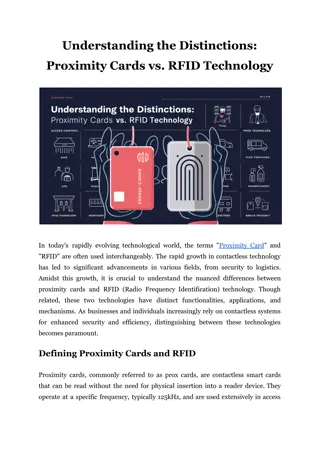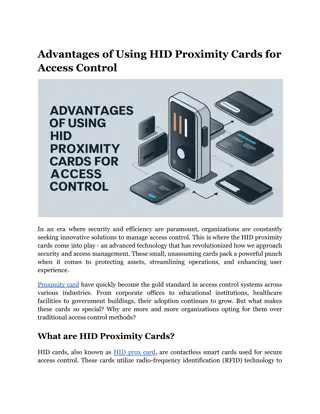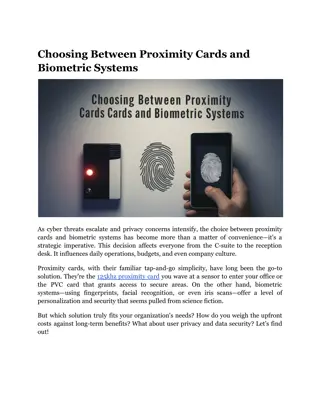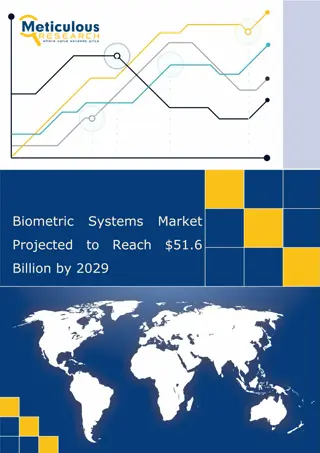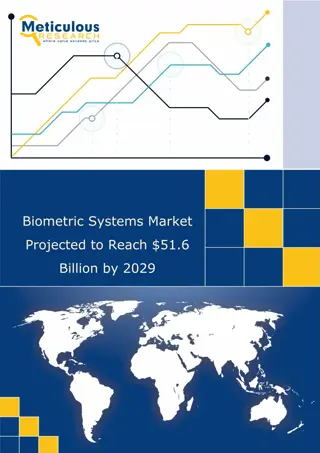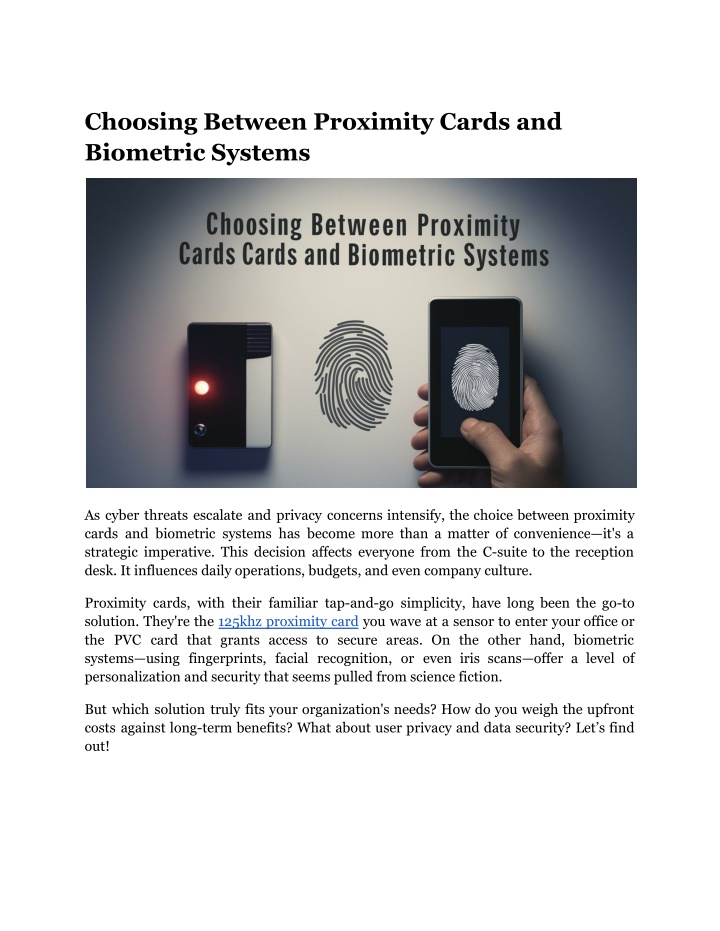
Choosing Between Proximity Cards and Biometric Systems
Discover the pros and cons of proximity cards and biometric systems to choose the best security solution for your needs.
Download Presentation

Please find below an Image/Link to download the presentation.
The content on the website is provided AS IS for your information and personal use only. It may not be sold, licensed, or shared on other websites without obtaining consent from the author. If you encounter any issues during the download, it is possible that the publisher has removed the file from their server.
You are allowed to download the files provided on this website for personal or commercial use, subject to the condition that they are used lawfully. All files are the property of their respective owners.
The content on the website is provided AS IS for your information and personal use only. It may not be sold, licensed, or shared on other websites without obtaining consent from the author.
E N D
Presentation Transcript
Choosing Between Proximity Cards and Biometric Systems As cyber threats escalate and privacy concerns intensify, the choice between proximity cards and biometric systems has become more than a matter of convenience it's a strategic imperative. This decision affects everyone from the C-suite to the reception desk. It influences daily operations, budgets, and even company culture. Proximity cards, with their familiar tap-and-go simplicity, have long been the go-to solution. They're the 125khz proximity card you wave at a sensor to enter your office or the PVC card that grants access to secure areas. On the other hand, biometric systems using fingerprints, facial recognition, or even iris scans offer a level of personalization and security that seems pulled from science fiction. But which solution truly fits your organization's needs? How do you weigh the upfront costs against long-term benefits? What about user privacy and data security? Let s find out!
Proximity Card Technology What is a Proximity Card? It is a contactless smart card used for secure access control. These cards contain an embedded antenna and a chip that stores a unique identification number. When brought near a card reader, the card is powered by electromagnetic waves and transmits its ID to the reader. Key features include: Contactless operation Durability and long lifespan Compatibility with various access control systems Ability to be printed with visual identification elements Companies like Bristol ID Technologies offer a range of proximity card solutions tailored to diverse security needs across industries. Read More Article: Private Jet Travel Etiquette: Do's and Don'ts in the Sky Types of Proximity Cards There are several types available in the market: ISO PVC Proximity Card: These cards conform to international standards for thickness and dimensions, making them widely compatible with different systems. Clamshell Cards: Thicker and more durable, these are ideal for harsh environments. Proximity Smart Card: Combines proximity technology with additional smart card capabilities for enhanced functionality. Key Fob: A compact, keychain-friendly alternative to card-style proximity devices. Biometric Systems What is a Biometric System? Biometric systems use unique physical characteristics of individuals for identification and access control. Common biometric identifiers include:
Fingerprints Facial features Iris patterns Hand geometry Voice recognition These systems capture and store biometric data, comparing it to a database of authorized individuals when access is requested. Types of Biometric Systems Fingerprint Scanners: The most common and cost-effective biometric solution. Facial Recognition: Increasingly popular due to its non-contact nature and improving accuracy. Iris Scanners: Highly secure but more expensive to implement. Hand Geometry Readers: Suitable environments. for high-traffic areas and dirty Comparing Proximity Cards and Biometric Systems Security Proximity Cards: Can be lost, stolen, or shared Encryption methods vary in strength 125khz proximity card technology is vulnerable to cloning Biometric Systems: Highly secure, as biometric data is unique to each individual Difficult to forge or replicate Some systems can be fooled by high-quality fakes or images User Convenience Proximity Cards: Easy to use, requiring a simple tap or wave Can double as visual ID badges
May be integrated with other systems (e.g., time and attendance) Biometric Systems: No need to carry a physical credential Cannot be forgotten or lost May require multiple attempts for successful reading Cost Proximity Cards: Lower initial implementation cost Ongoing costs for card replacement and management ISO PVC proximity card options offer cost-effective solutions for large organizations Biometric Systems: Higher upfront costs for readers and software Minimal ongoing costs, as there are no physical credentials to replace Potential cost savings in the long run for high-security applications Scalability Proximity Cards: Easily scalable to accommodate growing user bases Simple to integrate with existing systems Proximity smart card technology allows for multi-application use Biometric Systems: Scalability can be complex and expensive May require significant infrastructure changes for large-scale implementation Database management becomes more challenging as user numbers grow Privacy Concerns Proximity Cards: Generally raises fewer privacy concerns Data stored is typically limited to an ID number
Biometric Systems: Can raise significant privacy concerns Require careful handling and protection of sensitive biometric data May face legal and regulatory challenges in some jurisdictions Factors to Consider When Choosing Security Level Required: Assess the sensitivity of the areas being protected and the potential risks involved. User Population: Consider the size and nature of the user base, including factors like turnover rate and user tech-savviness. Budget: Evaluate both initial implementation costs and long-term operational expenses. Environmental Conditions: Consider the physical environment where the system will be deployed (e.g., indoor vs. outdoor, clean vs. dirty). Integration Requirements: Assess compatibility with existing systems and future expansion plans. Legal and Regulatory Compliance: Ensure the chosen system complies with relevant laws and regulations, particularly regarding data privacy. User Acceptance: Consider how employees or users will react to the chosen technology. Hybrid Solutions In many cases, organizations find that a hybrid approach combining Proximity ID cards with biometric systems offers the best solution. This approach can provide: Enhanced security through multi-factor authentication Flexibility in access control implementation A gradual transition from card-based to biometric systems Read More Article: The Top Benefits of Choosing Private Flights in Los Angeles Implementation Best Practices Regardless of the chosen technology, consider these best practices for implementation: Conduct a thorough risk assessment and needs analysis Involve stakeholders from various departments in the decision-making process
Provide comprehensive training for both administrators and end-users Implement strong data protection measures, especially for biometric data Regularly review and update access control policies and procedures Plan for system maintenance and updates Develop a clear incident response plan for security breaches or system failures Ensure scalability in your chosen solution to accommodate future growth Implement a phased rollout strategy to minimize disruption and allow for adjustments Establish a feedback mechanism for users to report issues and suggest improvements The Bottom Line While Proximity ID cards offer a tried-and-true solution with wide compatibility and ease of use, biometric systems provide enhanced security and convenience. Many organizations find that a hybrid approach, integrating the strengths of both technologies, offers the most comprehensive solution. Ultimately, the right choice will depend on a careful analysis of an organization's specific requirements, constraints, and long-term security goals. Choose Bristol ID Technologies, and you're not just selecting a product you're forging a partnership with the vanguard of identity security. With clients across continents, we bring a global perspective to local security challenges. Our R&D team pushes the boundaries of what's possible, consistently delivering solutions that are steps ahead of potential threats. Every card we produce undergoes rigorous testing, guaranteeing performance that exceeds industry standards. Site Article: Choosing Between Proximity Cards and Biometric Systems








